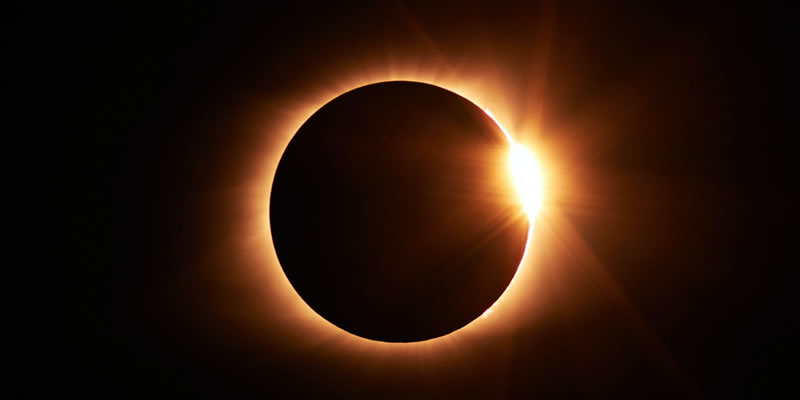 Web Content Display
Web Content Display

Solar Eclipse
Tab Menu
 Web Content Display
Web Content Display
Solar Eclipses occur when the Sun is obscured by the Moon, an occasion when the Sun, the Moon and the Earth are in near alignment when the Earth moves into the Moon's umbra or penumbra.
There are three kinds of Solar Eclipses, namely Total Solar Eclipses, Partial Solar Eclipses and Annular Solar Eclipses.
Since the Moon's orbit around the Earth is not in the same plane as the Earth's orbit around the Sun, eclipses do not occur every month. However, contrary to popular belief, solar eclipses are not at all rare. In any one calendar year, there are at least two Solar Eclipses. In some years, notably in the year 2011, there were as many as four. As the path of totality is very narrow, people in a certain region can only observe, on average, a Partial Solar Eclipse every two to three years, while the chance of observing a truly remarkable Total Solar Eclipse is extremely remote. No Total Solar Eclipses will be visible from Hong Kong in the coming century.
 Web Content Display
Web Content Display
| Date (HKT) | Type | Area of Visibility | Hong Kong |
|---|---|---|---|
| 2021.06.10 | Annular | Much of Europe, Much of Asia, North/West Africa, Much of North America, Atlantic and Arctic | not visible |
| 2021.12.04 | Total | South in Australia, South in Africa, South in South America, Pacific, Atlantic and Indian Ocean | not visible |
| 2022.04.30 | Partial | South/West South America, Pacific, Atlantic and Antarctica | not visible |
| 2022.10.25 | Partial | Europe, South/West Asia, North/East Africa and Atlantic | not visible |
| 2023.04.20 | Annular-Total | South/East Asia, Australia, Pacific, Indian Ocean and Antarctica | partial |
| 2023.10.14 | Annular | Western Africa, North America, South America, Pacific, Atlantic and Arctic | not visible |
| 2024.04.08 | Total | Much of Europe, Northern Asia, Northern/Western Africa, Much of North America, Atlantic and Arctic | not visible |
| 2024.10.02 | Annular | Much of South America, Pacific, Atlantic and Antarctica | not visible |
| 2025.03.29 | Partial | Much of Europe, Northern Asis, Northern/Western Africa, Much of North America, Atlantic and Arctic | not visible |
| 2025.09.21 | Partial | Southern Australia, Pacific, Atlantic and Antarctica | not visible |
| 2026.02.17 | Annular | Antarctica (annular eclipse); Africa, South America, Pacific Ocean, Atlantic Ocean, and Indian Ocean (partial eclipse) |
not visible |
| 2026.08.12 | Total |
Greenland, Iceland, Spain, Russia, and a small area of Portugal (total eclipse); |
not visible |
| 2027.02.06 | Annular |
Chile, Argentina, and Atlantic (annular eclipse); South America, Antarctica, and Southern & Western Africa (partial eclipse) |
not visible |
| 2027.08.02 | Total |
Morocco, Spain, Algeria, Libya, Egypt, Saudi Arabia, Yemen, and Somalia (total eclipse); Africa, Europe, Middle East, and Southern & Western Asia (partial eclipse) |
not visible |
| 2028.01.26 | Annular |
Ecuador, Peru, Brazil, Suriname, Spain, and Portugal (annular eclipse); Eastern North America, Central & South America, Western Europe, and Northwestern Africa (partial eclipse) |
not visible |
| 2028.07.22 | Total |
Australia, and New Zealand (total eclipse); |
visible |
| 2029.01.14 | Partial |
North America, and Central America |
not visible |
| 2029.06.12 | Partial |
Arctic, Scandinavia, Alaska, Northern Asia, and Northern Canada |
not visible |
| 2029.07.11 | Partial |
Southern Chile, and Southern Argentina |
not visible |
| 2029.12.05 | Partial |
Southern Argentina, Southern Chile, and Antarctica |
not visible |
| 2030.06.01 | Annular |
Algeria, Tunisia, Greece, Turkey, Russia, Northern China, and Japan (annular eclipse); |
visible |
| 2030.11.25 | Total |
Botswana, South Africa, and Australia (total eclipse); |
not visible |
